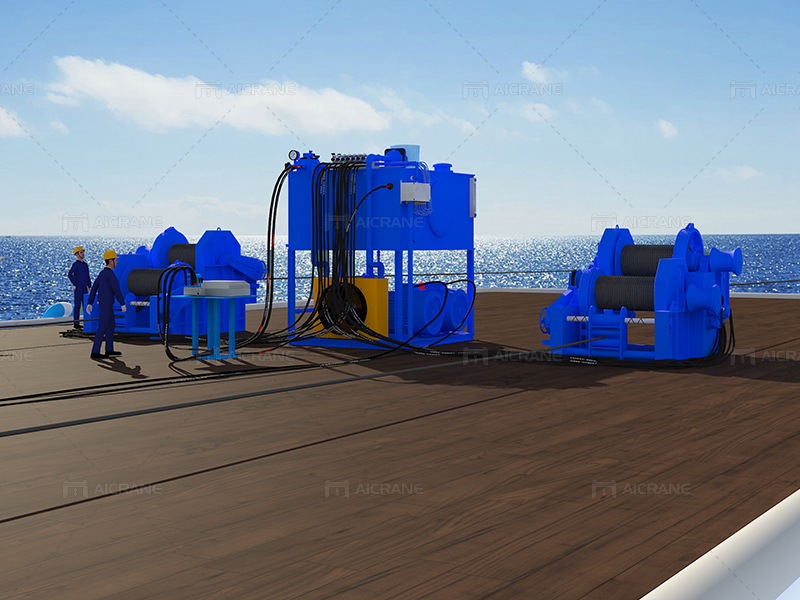Maintaining the hydraulic pump station of a 50 ton hydraulic winch is crucial for ensuring smooth and reliable operation, minimizing downtime, and extending the lifespan of the equipment. Hydraulic winches are widely used in various industries for heavy-duty lifting and pulling tasks, and their hydraulic pump stations play a critical role in powering the winch’s hydraulic system. Proper maintenance practices can help prevent costly repairs, enhance performance, and ensure safe operation. Let’s delve into the key steps and best practices for maintaining the hydraulic pump station of a 50 ton hydraulic winch:

Regular Inspection and Monitoring
Conduct regular visual inspections of the hydraulic pump station to check for leaks, damage, loose connections, and abnormal vibrations. Inspect hydraulic hoses, fittings, seals, valves, and reservoirs for signs of wear, corrosion, or deterioration. Monitor fluid levels, pressure gauges, and temperature readings to ensure optimal hydraulic system performance. Keep a maintenance log to track inspection results, maintenance tasks, and equipment conditions over time.
Fluid Management and Filtration
Maintain proper fluid levels and cleanliness in the hydraulic pump station by regularly checking and replenishing hydraulic fluid as needed. Use high-quality hydraulic fluid recommended by the manufacturer to ensure compatibility and performance. Implement a regular fluid analysis and filtration program to remove contaminants, dirt, and moisture from the hydraulic system. Replace hydraulic filters and filter elements based on manufacturer’s recommendations to prevent clogging and maintain fluid quality.
Lubrication and Greasing
Lubricate moving parts, bearings, and components of the hydraulic pump station to reduce friction, wear, and heat generation. Use recommended lubricants and greases for specific components such as pump bearings, motor shafts, and hydraulic cylinders. Apply lubrication according to manufacturer guidelines and maintenance schedules to ensure proper lubrication coverage and effectiveness. Regular greasing and lubrication help prolong component life and maintain hydraulic system efficiency.
Pressure Testing and Adjustment
Perform regular pressure testing and adjustment of the hydraulic pump station to ensure optimal pressure levels and system performance. Use pressure gauges, flow meters, and pressure relief valves to monitor and adjust hydraulic pressure as needed. Conduct pressure tests during scheduled maintenance intervals or after significant system changes to verify hydraulic system integrity and functionality. Adjust pressure settings within recommended limits to prevent overloading or system malfunctions.
Seal and O-Ring Inspection
Inspect hydraulic seals, O-rings, gaskets, and seals for signs of wear, leaks, or damage. Replace worn or damaged seals promptly to prevent hydraulic fluid leaks and contamination. Check seal integrity during routine inspections and whenever hydraulic components are disassembled or serviced. Use compatible seal materials and lubricants to ensure proper sealing and prevent hydraulic winch system leaks.
Cooling System Maintenance
Maintain the cooling system of the hydraulic pump station to prevent overheating and ensure optimal operating temperatures. Clean and inspect hydraulic oil coolers, heat exchangers, and cooling fans regularly to remove dirt, debris, and blockages. Check coolant levels, hoses, and connections for leaks or damage. Ensure proper airflow and ventilation around cooling components to dissipate heat effectively and maintain hydraulic system stability.
Electrical System Checks
Inspect electrical components such as wiring, connectors, switches, and control panels associated with the hydraulic pump station. Ensure proper electrical connections, grounding, and insulation to prevent electrical faults, shorts, or malfunctions. Test electrical circuits, sensors, and safety interlocks regularly to verify functionality and compliance with safety standards. Address any electrical issues promptly to prevent equipment downtime or safety hazards.
Training and Operator Awareness
Provide comprehensive training to operators and maintenance personnel on hydraulic pump station maintenance, troubleshooting, and safety procedures. Educate operators on proper equipment operation, fluid handling, and maintenance best practices. Encourage operators to report any abnormal hydraulic winch system behavior, leaks, or performance issues for immediate investigation and resolution. Promote a culture of proactive maintenance and equipment care to enhance reliability and performance.
Documentation and Record Keeping
Maintain accurate documentation and records of hydraulic pump station maintenance activities, inspections, repairs, and component replacements. Keep service manuals, maintenance schedules, parts lists, and fluid analysis reports up to date. Document maintenance procedures, safety guidelines, and operational instructions for reference and training purposes. Use maintenance software or systems to track maintenance tasks, equipment history, and compliance with maintenance schedules.
By following these maintenance practices and implementing a proactive maintenance program, operators can ensure the reliable performance and longevity of the hydraulic pump station in a 50 ton hydraulic winch. Regular inspections, fluid management, lubrication, pressure testing, seal checks, cooling system maintenance, electrical checks, training, and documentation are essential elements of effective hydraulic pump station maintenance. Prioritize equipment care, safety, and compliance to maximize productivity, minimize downtime, and protect the investment in hydraulic winch equipment.